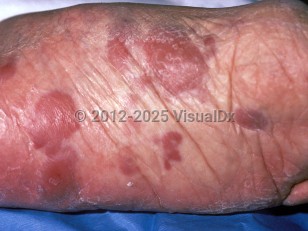Cutaneous B-cell lymphoma
Alerts and Notices
Important News & Links
Synopsis

Multiple staging systems are available, including the World Health Organization-European Organization of Research and Treatment of Cancer (WHO-EORTC) 2005 classification and the WHO 2008 / 2016 classification. This presents controversy regarding exact classification. This article will focus on the 4 clearly defined types of CBCL.
Follicle center lymphoma and marginal zone lymphoma (eg, extranodal) are considered indolent, while aggressive disease entities include diffuse large B-cell lymphoma (DLBCL), leg type, and intravascular DLBCL. Crosti lymphoma is a variant of follicle center lymphoma that presents on the back. Since the skin can be involved secondary to all B-cell lymphomas and leukemias, staging must be performed once CBCL has been diagnosed. Primary CBCL is defined as disease limited to the skin.
Signs and symptoms vary based on the subtype of disease. In general, one or more red, brown, and purple papules or nodules, tumors, and plaques can be present on various parts of the skin. B symptoms (fever, weight loss, and night sweats) may or may not be present.
The etiology is unknown, but the immune system and genome likely both play a role. Specific gene alternations in primary cutaneous disease are not well defined. Borrelia species may play a role in some cases, particularly in endemic areas of Europe such as Scotland and Austria. Immunosuppressed patients, such as solid organ transplant recipients and people with AIDS, have higher risk of disease. Increased disease prevalence has also been seen in cases of iatrogenic immunosuppression with medications like methotrexate. Some CBCLs are associated with Epstein-Barr virus infection. Patients receiving chemotherapy and radiotherapy are at increased risk of non-Hodgkin lymphoma.
Primary CBCL is rarely seen in children and equally affects men and women. There are differences in the epidemiology of the disease based on region. Of all cutaneous lymphomas, 5% of cases are CBCL in the United States; comparatively, CBCL comprises 23% of all cutaneous lymphoma cases in Holland and Austria. Follicle center lymphoma and marginal zone lymphoma are most common, followed by DLBCL, leg type. The most common subtype of lymphoma is DLBCL not otherwise specified. This diagnosis is utilized for DLBCLs that do not meet criteria for a subtype of the disease.
Prognosis varies by type of lymphoma. Primary cutaneous follicle center lymphoma has a good prognosis with rare involvement of lymph nodes or other organs. Primary cutaneous marginal zone lymphoma has a good prognosis as well without internal disease. Primary cutaneous DLBCL, leg type, has a poor survival rate of approximately 50% at 5 years. Similarly, intravascular DLBCL has a poor prognosis.
Treatment options include radiation, surgical excision, and systemic as well as intralesional anti-CD20 monoclonal antibodies such as rituximab. Systemic chemotherapy is usually not beneficial.
Related topic: Non-Hodgkin lymphoma
Codes
C85.10 – Unspecified B-cell lymphoma, unspecified site
SNOMEDCT:
402881008 – Cutaneous B-cell lymphoma
Look For
Subscription Required
Diagnostic Pearls
Subscription Required
Differential Diagnosis & Pitfalls

Subscription Required
Best Tests
Subscription Required
Management Pearls
Subscription Required
Therapy
Subscription Required
Drug Reaction Data
Subscription Required
References
Subscription Required
Last Updated:02/23/2022

